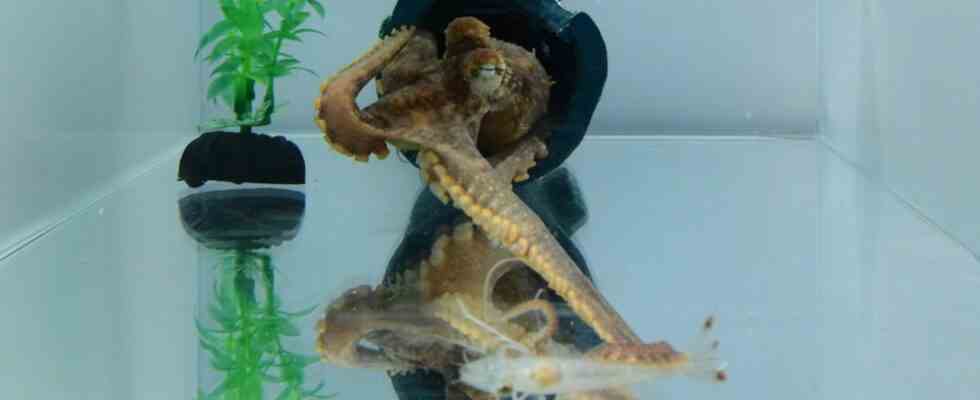Always with the same arm ahead
Fascinating recordings: An octopus hunts so cleverly and effectively
Credit: Wardill Lab, University of Minnesota
In the video (no sound): Octopuses don’t just poke around wildly with their arms, they hunt with a system. Scientists have made fascinating discoveries about cephalopod hunting behavior. The individual tactics are impressively documented in a video published with the findings.
Scientists observed octopuses hunting. It turned out that the cephalopods proceed with a system and extremely effectively.
A crab sinks to the bottom in a tank of water and tries to crawl away. She doesn’t get far. An octopus crouching in a tube rushes in, pulls itself over the crustacean and retreats with the prey (the scene can be seen from about minute 0:46 in the video). What at first sight seems like the hasty attack of a greedy robber follows an effective system. Scientists from the University of Minnesota have observed captive octopuses while they hunt and have discovered fascinating things about the eight-legged creatures.
Study of octopuses on the hunt
For a study that they published in the journal “Current Biology”, the researchers examined, among other things, whether octopuses prefer certain arms when hunting and use them differently, i.e. whether they are “left-handed or right-handed” (of course taking into account that the animals have four tentacles on the left and right).
For the study, the scientists observed the California two-spotted octopus. The animals are about the size of a tennis ball and live for about two years. The researchers numbered the arms on either side of the body and dropped different prey items into the octopus’ tank: crabs and shrimp. The cephalopods lurked in their hiding place, one eye forward. The hunting scenes were filmed and evaluated.
Octopuses always launch attacks with the same arm
The prey animals were chosen because they each require a different hunting tactic, they say. Crabs move more slowly, while shrimp can swim away quickly with a flick of their tail. Here’s what the researchers observed: When chasing crabs, the octopuses pounced on the prey with a swift, feline motion. If there was a shrimp in the tank, the robbers proceeded more slowly, more deliberately, so as not to frighten their prey and possibly let it escape. The octopus first slowly groped its way forward with an attacking arm. Only after that arm had grabbed the shrimp were the nearest neighboring arms deployed to provide support.
No matter what prey was in the tank, each octopus would always attack second arm first. Whether with the second from the left or the right again depended on which side the eye was in whose field of vision the object of desire was moving.
Study should help in the development of robots
Flavie Bidel, lead author of the study, was particularly surprised at how predictable the hunting movements of all the animals observed in the experiment were. Above all, the fact that the attack was always carried out first with the second arm is remarkable given that the movements initially appear so unpredictable. The findings of the study should be useful in future in the development of robots and underwater vehicles.
Source:University of Minnesota

